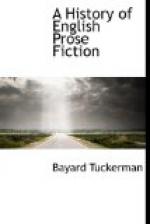At the head of New England, and, indeed, of American writers of fiction, stands Nathaniel Hawthorne. His three great works, “The Scarlet Letter,” “The House of the Seven Gables,” and “The Blithedale Romance,” are the finest specimens of imaginative writing which American genius has yet produced. The interest of Hawthorne’s novels lies almost entirely in their subtle and astute studies of the hidden workings of the human mind. His fictions are remarkable for their want of action. “The Scarlet Letter” can hardly be said to have a plot. The series of chapters which intervene between the exhibition of Hester Prynne on the scaffold and the voluntary self-exposure there of the Puritan minister, simply represent gradual changes from the first to the last situation of the principal characters. But narrative excitement was never Hawthorne’s object, and the want of it is never felt by his reader. Each scene is an appropriate sequel to the last, and a natural introduction to the next. Each chapter has its special interest,—the analysis of a condition of mind, a dramatic situation, or a highly finished domestic picture. It is in the delineation of character and the study of human motives that Hawthorne’s chief excellence as a novelist consists. Nothing can exceed the penetration and vividness with which such persons as Zenobia, in “The Blithedale Romance,” and Holgrave, in “The House of the Seven Gables,” are described. The homeward walk of the fallen young minister, in “The Scarlet Letter,” when he had resolved to desert his flock and to connect himself again with Hester Prynne, is an unsurpassed delineation of sudden moral degeneration. There is nothing of modern realism in Hawthorne’s novels, and yet they leave a realistic impression behind them. The greater number of his characters appear to us rather as representatives of certain mental conditions then as real flesh and blood. Neither in the dialogue, nor in what may be called the “properties” of his writing did Hawthorne strive at realistic effects. Still, when the reader lays down “The Scarlet Letter,” or “The House of the Seven Gables,” he insensibly feels himself embued with the spirit and atmosphere of Puritan New England. Hawthorne was so intensely a New Englander in his sympathies, prejudices, and habits of mind, that his writings were always colored by the thought and sentiment of his native land. In “The Scarlet Letter,” there is little evidence of the use of historical researches, and yet in that volume, colonial life has been made real and actual to us by the very intensity of the author’s national feeling.
New England fiction includes a number of other celebrated and honored names. Catherine M. Sedgwick began her literary career with “Hope Leslie,” a story founded on the early history of Massachusetts, which was followed by “Redwood” and “The Linwoods, or Sixty Years Since in America.” Dr. Oliver Wendell Holmes studied New England village life in “Elsie Venner,” and Sylvester Judd that of the Maine backwoods in “Margaret.” Mr. T.W. Higginson has written “Malbone.” Mr. W.D. Howells, Rev. Edward Everett Hale, and Miss E.S. Phelps are still adding to their reputations.




